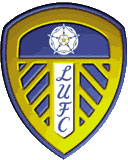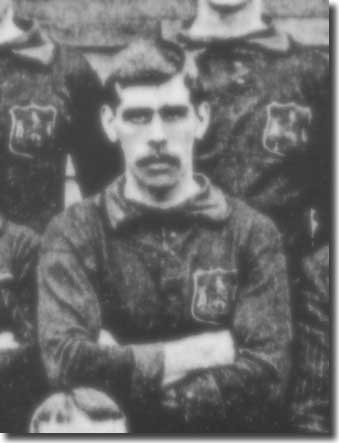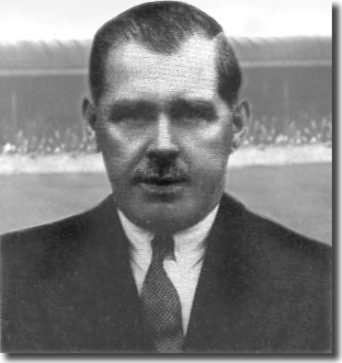 |
 |
 |
Ray was born in the Potteries town of Newcastle-under-Lyme on 4 February
1876 and began his footballing career with local clubs, joining Macclesfield
as a seventeen year old in 1893, before moving to Burslem Port Vale a
year later. Over the next few years he played for Macclesfield, Manchester
City, Lincoln City, Doncaster Rovers, Macclesfield (again), Manchester
City (again), Coventry City, Stockport County and Chesterfield. After Gilbert Gillies, his manager at Chesterfield,
was appointed as Leeds City's first boss in March 1905, the 29 year old
Ray followed him to Elland Road in July, in time for the club's first
season in the Football League. Ray was a dependable left-back and even
skippered the side before leaving when the board declined not to renew
Gillies' contract in March 1908. Ray retired from playing in 1912 after a time at Mirfield United and
then served in the RASC during World War One. He remained close to Leeds
City, however, and was invited to become a member of the original committee
that was elected to manage the new Leeds United, following City's
expulsion from the League in October 1919. He then became the first
United manager, running the club for part of their 1919/20 Midland League
campaign. New United chairman Hilton Crowther went back to his old club Huddersfield
Town to recruit Arthur Fairclough in February
1920. Ray became his assistant for a while, eventually leaving Elland
Road in June 1923 to take over at Doncaster Rovers when they were elected
to the old Third Division (North). Ray never got them above a mid table
finish, but when Arthur Fairclough resigned following Leeds United's relegation
to Division Two at the end of 1926/27, the Leeds Board recalled him to
oversee all team and football affairs, including selection and tactics. One of Ray's first signings, in July 1927, was Charlie Keetley, whom
he seized from non League obscurity. Keetley went on to score more than
a hundred goals for United over the next seven years, and is still one
of the club's all time leading goalscorers. Ray had previously signed
all of his four brothers while at Doncaster. Ray steered United back up to the First Division at the first attempt
in 1927/28, making few changes to Fairclough's team, although Keetley
had a good late run, scoring 18 goals in his 16 appearances. He went on
to steer the club to a remarkable top five finish in 1929/30 (their best
placing until Don Revie arrived), before seeing them relegated the following
year. They bounced back immediately in 1931/32 as runners up to Wolves
and enjoyed two seasons in mid-table. Ray now had the celebrated England
international half back line of Edwards, Hart and Copping at his disposal. However, in the close season of 1934, powerful Arsenal, the 'Bank of
England' club stole Throughout his career, Ray was self assured, opinionated and outspoken.
Few argued with his achievements and, despite perpetual financial problems,
while he was at Elland Road, he fashioned a strong outfit. He discovered
and developed the likes of Bert Sproston, Wilf Copping, Billy Furness
and Eric Stephenson who all made it into the England side, as did two
of the players he inherited, Willis Edwards and Ernie Hart. The Football League recognised Ray's achievements by appointing him the
first manager of a League representative team, for the 2-2 draw with the
Scottish League at Ibrox in February 1934. He was presented with a gold
medal to mark the honour. Ray quit his £1,000 a year post on 5 March 1935, deciding he had
taken United as far as he could. A month later, he took over from Jack
Peart as Bradford City manager. They just about avoided relegation from
Division Two at the end of that season, but were relegated in 1937. Ray
left the club a year later when he was relieved of responsibility for
team selection. He was then 62 and spent some time as Millwall's chief scout, but was
out of football two years later, spending his time running garage businesses
and billiard salloons. Ray was also a fine cricketer with Bradford League club Laisterdyke. He died on 28 December 1952 in St James' Hospital in Leeds, aged 76. Dick
Ray was one of the most loyal servants ever at Elland Road, serving both
Leeds City and United for well over thirty years, although he had a number
of breaks from the place. As well as being manager of United in two separate
spells, he was also player and captain of City, as well as being committee
man and secretary with United.
Dick
Ray was one of the most loyal servants ever at Elland Road, serving both
Leeds City and United for well over thirty years, although he had a number
of breaks from the place. As well as being manager of United in two separate
spells, he was also player and captain of City, as well as being committee
man and secretary with United. Copping
away, sorely depleting the United backbone. Copping was badly missed.
In 1934/35 Leeds sank to 18th place, though with only four points fewer
than in the previous campaign. But defensively there were some dreadful
embarrassments: an 8-1 defeat at Stoke in the second match of the season,
a 6-3 defeat at West Bromwich in November and a 7-1 thrashing at Chelsea
in March - despite Leeds having taken a 10th minute lead in the latter.
By then, Dick Ray had resigned as manager. With only slender resources
at his disposal, he did much to enhance Leeds United's reputation, fostering
the talents of several fine young players, but felt there was little more
progress he could make. 59 year old Ray resigned his £1,000 a year job
on 5 March 1935, with United flirting once more with relegation.
Copping
away, sorely depleting the United backbone. Copping was badly missed.
In 1934/35 Leeds sank to 18th place, though with only four points fewer
than in the previous campaign. But defensively there were some dreadful
embarrassments: an 8-1 defeat at Stoke in the second match of the season,
a 6-3 defeat at West Bromwich in November and a 7-1 thrashing at Chelsea
in March - despite Leeds having taken a 10th minute lead in the latter.
By then, Dick Ray had resigned as manager. With only slender resources
at his disposal, he did much to enhance Leeds United's reputation, fostering
the talents of several fine young players, but felt there was little more
progress he could make. 59 year old Ray resigned his £1,000 a year job
on 5 March 1935, with United flirting once more with relegation.